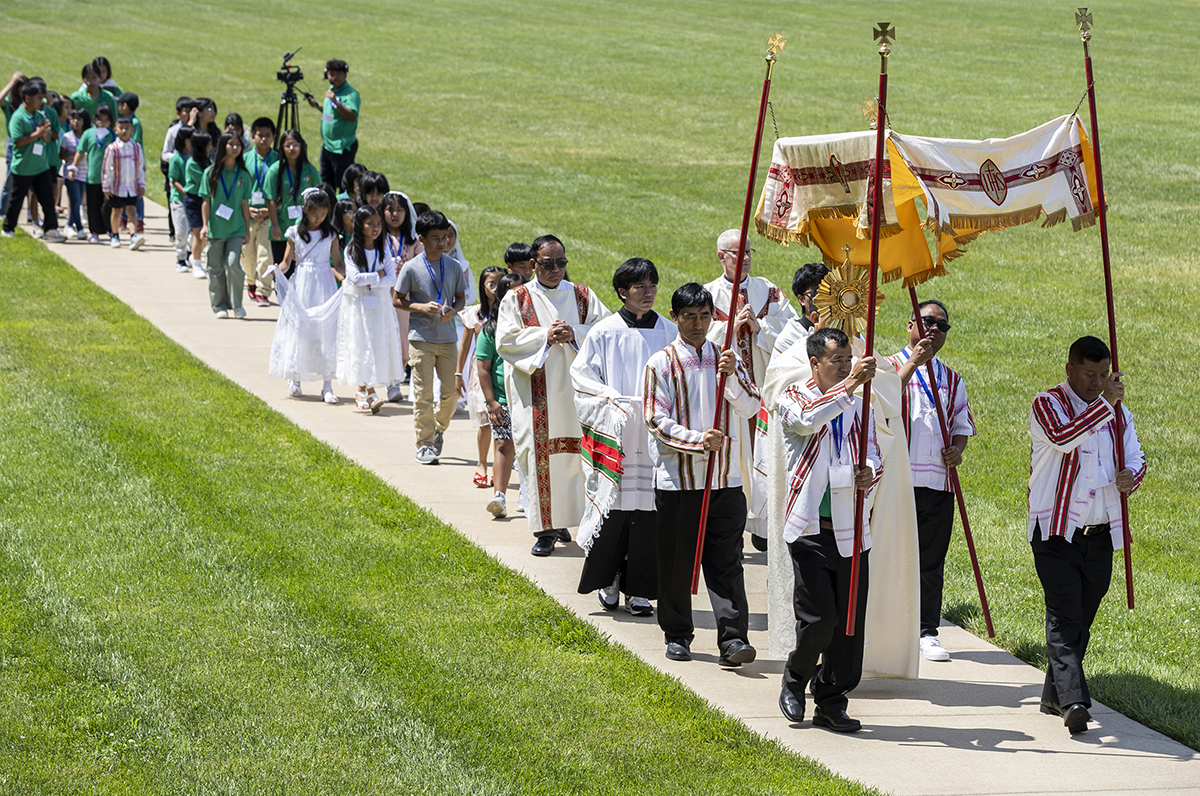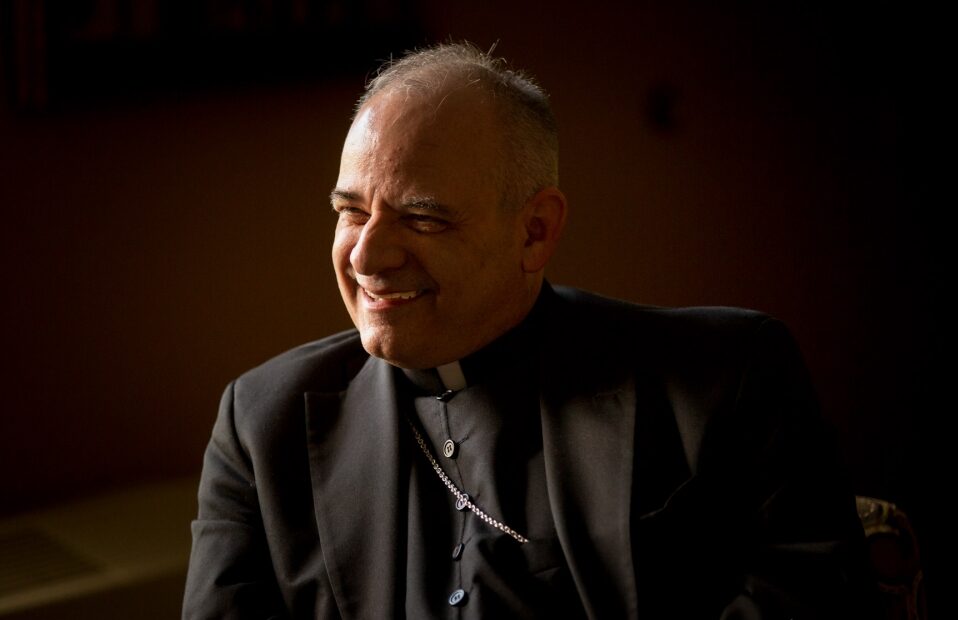Scientist promotes action for ‘Our Common Home’

SLU professor sees role for faith, science in caring for the earth

Using Pope Francis’ “Laudato Si’ (Our Common Home)” as a guide, Benjamin de Foy asks people to examine their care for the earth through personal actions, societal actions, and hopes and dreams.
De Foy is a professor of atmospheric science at Saint Louis University who uses computer models to better understand emissions of air pollutants.
“We can disagree on policies and on the role of government, on subsidiarity and on regulations. But as Christians, it is important that we feel the pain of things that have gone wrong,” de Foy said.
Since the release of Pope Francis’ encyclical five years ago, de Foy has used his scientific background, his passion for the environment and his admiration for the encyclical to spread the word about it throughout the archdiocese. His most recent talk was part of a panel discussion sponsored by the Archdiocese of St. Louis Oct. 1 on the encyclical and its relation to faith, science, justice and creation.
Citing The Keeling Curve, a measurement of carbon dioxide concentration from the top of Mauna Loa in Hawaii, he stated that CO2 has increased nearly 50% since pre-industrial times. The isotopes of carbon in the CO2 show that it comes from fossil fuels that were pumped out of the ground and burned into the atmosphere by humans, he said.
He also cited the rise in global average daily temperature, with 2020 on track to surpass 2016 as the hottest year on record; rising sea levels; and other changes.
In an interview, he said that as a lifelong Catholic who is a member of St. Francis Xavier (College Church) Parish in Midtown St. Louis, he sees the overlap between faith and science as a natural fit. “There’s a lot to know about nature and the wonder of creation,” he said. “Laudato Si’,” which includes many scriptural references, shows how care for the earth is integral to the faith, he added.
Interconnectedness is a theme in the encyclical that especially rings true to him. He cited a passage from St. Paul’s Letter to the Corinthians where he addresses divisions that people create (1 Corinthians 1:10-17).
Pope Francis’ thoughts are not new, de Foy said, since they follow statements by St. John Paul II and Pope Emeritus Benedict XVI. He admires how Pope Francis sought the best scientific advice possible as a starting point for the encyclical. Seeking to understand is a trait de Foy uses both in his scientific endeavors as well as other areas of his life.
Many of the changes in behavior that the encyclical recommends to address the “real problem” of climate change are steps people should take anyway, as a way of caring for God’s creation, de Foy said. These changes could be good for the economy, such as rehabbing houses to improve energy efficiency, he said. Addressing energy independence and renewability, preserving rainforests, creating green jobs, ensuring clean air and water, making cities more livable, improving children’s health, the sustainability of natural resources are all what he views as positive developments that also reduce carbon emissions.
The United States has made many strides in improving the environment, he said, citing for example the 1920s when St. Louis was so polluted that the Missouri Botanical Garden considered moving out of the city to escape pollution. Another example is the bald eagle which was on the edge of extinction and now can be seen in the wild. “It takes people of good will to say, ‘This is the vision we have.’”
If people listen to the scientific data and act, he said, things gradually will get better.
In his talks, he points to the Beatitudes and how they relate to our relationship with the environment. Hunger and thirst for righteousness, for example, can be applied to who is impacted by environmental destruction, de Foy said.
>> Atmospheric models
Benjamin de Foy simulates the winds in urban areas and during field campaigns.
The wind simulations tell where air pollutants are going as well as where they came from. He also simulates pollution transport and atmospheric chemistry.
These models can be combined with measurements of gases and particles in the atmosphere in order to estimate where and when pollutants are being emitted.
For example, he studied the emissions of fine particles in St. Louis, mercury pollution in Milwaukee and the transport and sources of pollution in Mexico City.
In addition to computer models, de Foy works with air pollution data collected by satellites. Currently, he’s studying the effect of a partial economic shutdown on air pollution.
Satellites constantly measure the amount of pollution in the atmosphere all over the globe, and this information tells about the emissions and also about the wind transport. De Foy was a member of NASA’s Air Quality Applied Science Team using satellite data to improve air quality. In Mexico City, for example, they can estimate the emissions of sulfur dioxide from a volcano on one side of the city and from an industrial complex on the other. The models can be used to figure out how much these sources impact people living there.
>> About ‘Laudato Si”
In 2015, Pope Francis released a letter to the worldwide Catholic Church and all people of good will on the importance of caring for our planet.
Among his points:
• Our Common Home Earth is in Crisis: “This sister (the Earth) now cries out to us because of the harm we have inflicted on her by our irresponsible use and abuse of the goods with which God has endowed her.”
• Gospel of Creation: “Living our vocation to be protectors of God’s handiwork is essential to a life of virtue; it is not an optional or a secondary aspect of our Christian experience.”
• Integral Ecology: “Strategies for a solution demand an integrated approach to combating poverty, restoring dignity to the excluded, and at the same time protecting nature.”
• Call to Action: A call to seek a new understanding of economy and progress. A call to dialogue among communities, states, nations, religions and science. A call to a new lifestyle and culture of care and concern for the common good. A call to hope.
To read “Laudato Si’” in its entirety, visit bit.ly/1Gi1BTu
Find more information from the U.S. Conference of Catholic Bishops on the encyclical at www.usccb.org/environment
“There is an urgent need to develop policies so that, in the next few years, the emission of carbon dioxide and other highly polluting gases can be drastically reduced, for example, substituting for fossil fuels and developing sources of renewable energy.”
Saint Louis University atmospheric scientist Benjamin de Foy collects data from an atmospheric measuring station to help create computer models to better understand emissions of air pollutants.Photo Credits: Lisa Johnston … Scientist promotes action for ‘Our Common Home’
Subscribe to Read All St. Louis Review Stories
All readers receive 5 stories to read free per month. After that, readers will need to be logged in.
If you are currently receive the St. Louis Review at your home or office, please send your name and address (and subscriber id if you know it) to subscriptions@stlouisreview.com to get your login information.
If you are not currently a subscriber to the St. Louis Review, please contact subscriptions@stlouisreview.com for information on how to subscribe.





